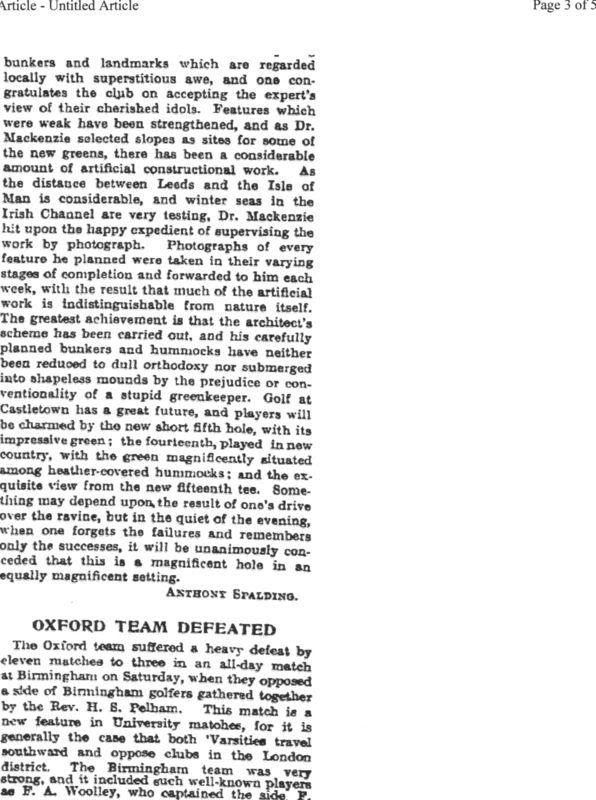Here are two articles -- sorry to break them into pieces. The first describes the fascinating method ("photographic supervision") Mackenzie used to oversee the reconstruction of Castletown Golf Links on the Isle of Man. The second reviews the completed course.
Kinda interesting to think about this as a course where he never set foot during construction -- without knowing of photographic supervision, one might conclude this was little more than a hit-and-run job where his involvement totaled just the initial plan.
The club has no records to confirm Mackenzie's involvement nor have any photographs turned up; however, these articles seem pretty clear indications he deserves some kind of design credit, if not post-Ross then pre-WWII.
As Tom MacW noted in another thread, Mackenzie did refer to Castletown in "Golf Architecture." Also, Neil Crafter has turned up a number of sources, including Kroeger's book on Old Tom Morris, stating Mackenzie's redesign.
This photographic supervision: it's fascinating, isn't it? From the start of his career MacKenzie found himself at odds with greenkeepers, green committees, "amateurs," et al who he saw as thwarting or incompetently executing his plans. It's interesting to speculate that many things for which MacKenzie is known -- principles, fancy routing maps, using local assistants, articles, and lectures -- may have had as their primary aim the successful implementation of his ideas, rather than the publicizing or marketing of said ideas or simple expediency.
Just speculation, but how could a guy who saw so few of his finished designs manage to get so lucky with great designs? Wouldn't he have to be able to enunciate his ideas and intentions, but also somehow ensure others both understood and agreed with those intentions?
Anyone with teenagers or in a managerial position can appreciate how difficult these things are to accomplish! Hiring the "right" people obviously is important, but how would he know they were the "right" people when he used local people, never saw the finished product, and didn't work with them again? And wouldn't he need to do more than hire to succeed? What's the point of his principles if not this? Were they primarily for marketing?
He wrote of facing similar frustrations in teaching and delegating camouflage work (engineers and military men being the primary targets there). So this communication / oversight challenge must have occupied a lot of his thinking time, yet how much do we know about how he operated?
IMHO it make sense that he would experiment with a variety of tools and methods aimed at communication of and adherence to his intentions, that these tools and methods served this specific purpose, not simply marketing.
Wonder if he tried photographic supervision again, and if not, why not?
First article appears in this post. Second article to follow in next post.
Mark


